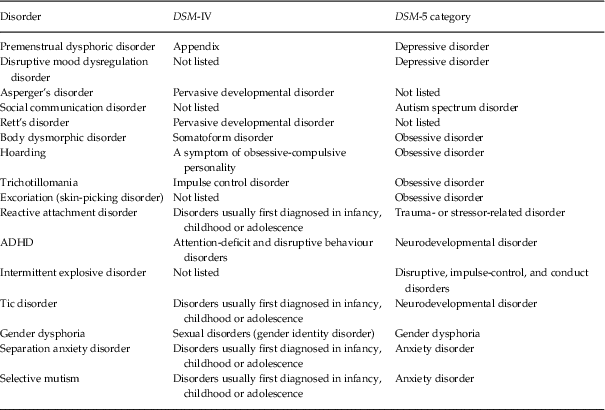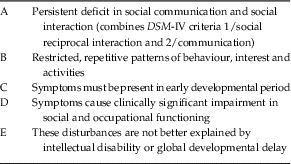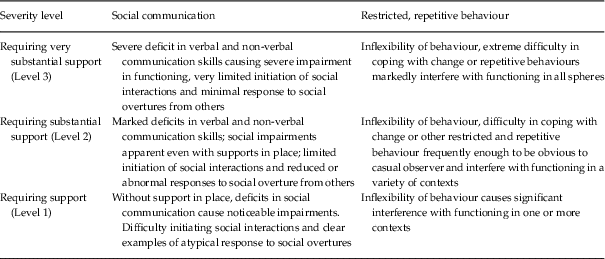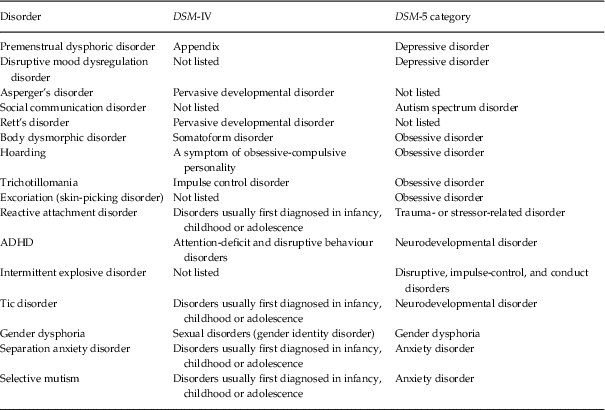Introduction
We aim to compare the Diagnostic and Statistical Manual of Mental Disorders-Fourth Edition (DSM-IV) and DSM-5, and to highlight new aspects of DSM-5 which are of particular relevance to child and adolescent psychiatrists in Ireland. This paper should be read in conjunction with the paper on Differences between DSM-IV and DSM-5 as applied to general adult psychiatry, by Murphy and Hallahan, Reference Murphy and Hallahan2016. We recommend also that the reader refers to a copy of the DSM-5 or the desk-reference to the DSM-5 while reading this article. The DSM-IV is well known by most child psychiatrists in Ireland, and was published in 1994 by the American Psychiatric Association (American Psychiatric Association, 1994) after years of research to modify and remove the inconsistencies from DSM-III. DSM-IV-TR (text revision) was later published in 2010. The APA worked with the developers of ICD-10 to increase the congruence between two systems.
The DSM-5 published in May 2013 by APA (American Psychiatric Association, 2013) has created considerable change from DSM-IV in relation to how disorders are diagnosed or listed as present or absent. The multi-axial classification system we are familiar with in DSM-IV has been replaced with a non-axial system, where multiple disorders or conditions can be diagnosed simultaneously, with the most prominent disorder usually listed first. In DSM-IV we have used Axis I Clinical Disorders, Axis II Personality Disorders and Mental Retardation, Axis III General Medical Condition, Axis IV Psychosocial and Environmental Problems and Axis V Global assessment of functioning, but now under DSM-5 the five axes of DSM-IV are combined into a single axis, with further specification about the presence of co-morbid conditions or level of functioning. For example the recording procedures of diagnosis have changed so that a child with DSM-IV pervasive developmental disorder not otherwise specified (PDD-NOS) that is associated with cerebral palsy will be recorded using DSM-5 as autism spectrum disorder (ASD) associated with cerebral palsy, and the severity will be specified according to the level of support (for ASD) required by the child. This is a considerable change from DSM-IV where the child would have been listed with a diagnosis of DSM-IV PDD-NOS under Axis 1 and with a medical condition under Axis III and the level of function listed under Axis V.
A further change in DSM-5 is that there has been a change from the categorical approach to the diagnosis of mental health disorders in DSM-IV to a dimensional approach in DSM-5, where the person’s symptoms may be described along a continuum, or listed as mild, moderate or severe. It is also possible to list a number of ‘specifiers’ to further describe co-morbid conditions which may accompany the disorder. This is of particular relevance in the diagnosis of ASD, where instead of using Axis V to describe the level of functioning we specify if the symptoms experienced by the young person are mild, moderate or severe. Using DSM-5 the presence of other medical conditions, psychosocial stressors or environmental factors can be listed simultaneously, and there is an extensive list of such factors included in DSM-5. Cultural issues are given more prominence, and rather than listing distinct culture-bound diagnoses there is now a chapter in DSM-5 called ‘Cultural formulation’ that ‘details a discussion of culture as it pertains to various diagnoses’ (Murphy and Hallahan, Reference Murphy and Hallahan2016). It is also important to note that the DSM-IV category ‘disorders usually first diagnosed in infancy, childhood or adolescence’ has been removed, and the disorders from that category are now listed elsewhere DSM-5, either in the chapter on neurodevelopmental disorders or alongside disorders noted in adult psychiatry.
This paper focuses on the differences between DSM-IV and DSM-5 in relation to attention-deficit/hyperactivity disorder (ADHD) and ASD. Some brief information is also provided on the changes in DSM-5 in relation to other disorders. We will also comment on the implications of the DSM-5 classification system for clinical practice in child and adolescent psychiatry in Ireland. Child psychiatrists in Ireland have in the past predominantly used DSM-IV for the diagnosis and classification of ADHD and of PDD. Many child psychiatrists use the ICD-10 classification system (WHO, 1992) for diagnosis and classification of other mental health disorders. ICD-10 does not list ADHD, but lists hyperkinetic disorder, which may or may not be associated with conduct disorder. It is not possible to diagnose ADHD inattentive type using ICD-10, which is one reason that DSM-IV was often used when working with ADHD, as well as the fact that most research on ADHD has used the DSM system of classification of disorders rather than the ICD system. It is interesting to note that the National Institute for Health and Care Excellence (NICE, 2016) guidelines issue guidelines on the management of ADHD, not on the management of hyperkinetic disorder, reflecting the widespread use of the term ADHD for children with this disorder.
Changes in the diagnosis of PDD/ASD
In DSM-IV the category of PDD includes five conditions (Table 1).
Table 1 Diagnostic and Statistical Manual of Mental Disorders-Fourth Edition pervasive developmental disorders

DSM-IV criteria for a diagnosis of autistic disorder include a total of six or more items of a list of 12 items, with four possible items of (1) qualitative impairment in social interaction, (2) qualitative impairment in communication and (3) restricted repetitive and stereotyped pattern of behaviour, interest and activities. There must be at least two items from the first category and one from each of the second categories for a diagnosis of autistic disorder. There must be delay or abnormal functioning in at least one of these categories before 3 years of age and the symptoms must not be due to childhood disintegrative disorder, or Rett’s disorder.
In comparison with this DSM-5 uses one umbrella term of ASD 299.00 for all these conditions, except Rett’s disorder, aiming to improve diagnosis without limiting the sensitivity of the criteria or substantially changing the number of children being diagnosed. The diagnosis of Asperger’s disorder is not present in DSM-5, and children who would previously have been diagnosed with Aspergers’s disorder are now diagnosed with ASD, with the severity of their disorder specified. DSM-5 describes symptoms of ASD under using five main criteria as shown in Table 2, with three possible symptoms of social communication and social interaction deficit and four possible items of restricted, repetitive patterns of behaviour, interest and activities. Severity levels are shown in Table 3, with measures of the support needed by the child.
Table 2 Autism spectrum disorder using Diagnostic and Statistical Manual of Mental Disorders (DSM)-Fifth Edition

Table 3 Severity levels for autism spectrum disorder in Diagnostic and Statistical Manual of Mental Disorders-Fifth Edition

Rett’s disorder is not listed in DSM-5, as this is now known to be due to a genetic disorder (Amir et al. Reference Amir, Van den Veyver, Wan, Tran, Francke and Zoghbi1999), and is thus a genetically distinct disorder from most cases of ASD. Children with Rett’s disorder who present with autistic symptoms can, however, be diagnosed with ASD, specified as ‘with known genetic or medical condition’. Most children with a well-established diagnosis of DSM-IV autistic disorder and those diagnosed with DSM-IV PDD-NOS should be given a diagnosis of ASD using DSM-5 (Kim et al. Reference Kim, Fombonne, Koh, Kim, Cheon and Leventhal2014; Ohashi et al. Reference Ohashi, Mizuno, Miyachi, Asai, Imaeda and Saitoh2015). However a new condition social communication disorder (SCD) is diagnosed if there are no restricted, repetitive patterns of behaviours, interests or activities. This change has been shown likely to reduce the current prevalence of ASD or PDD from 2.6% to 2.2%, though the combined rate of DSM-5 SCD and of DSM-5 ASD is expected to be very similar to the rate of DSM-IV PDD (Kim et al. Reference Kim, Fombonne, Koh, Kim, Cheon and Leventhal2014).
Under DSM-5 criteria, individuals with ASD must show symptoms from early childhood, even if the disorder is not recognised or diagnosed until later. This allows an early diagnosis of ASD in some cases, and also allows those people whose symptoms may not be fully recognised until the social demands exceed their capacity to receive a diagnosis at a later stage. This is a considerable change from DSM-IV, where there was more emphasis on a delay or abnormal function before 3 years of age.
Finally in DSM-5, ASD and ADHD can be simultaneously diagnosed. This was not possible in DSM-IV as the PDD diagnosis took precedence, though it was acknowledged that many children with ASD showed symptoms of ADHD also. A comparison study of DSM-5 criteria with DSM-IV found that most of patients with diagnosis of ASD under DSM-IV will retain their diagnosis under DSM-5 (Huerta et al. Reference Huerta, Bishop, Duncan, Hus and Lord2012).
Comparison of DSM-IV and DSM-5 for ADHD
ADHD is classified as a neurodevelopmental disorder in DSM-5, along with ASD, intellectual disabilities, specific learning disorders, and motor and communication disorders. This is a noticeable change from DSM-IV where ADHD was classified along with conduct disorder and oppositional defiant disorder in a category called ‘attention-deficit and disruptive behaviour disorders’. There is now a section for disruptive, impulse-control and conduct disorders in DSM-5, which has a new category intermittent explosive disorder as well as the conduct disorder and oppositional defiant disorder which we are generally familiar with. Hence there is now a marked separation of the oppositional disorders from ADHD, which is in keeping with the findings of research studies, which suggest that ADHD and conduct disorders have different aetiologies, though the disorders often co-exist (Dick et al. Reference Dick, Viken, Kaprio, Pulkkinen and Rose2005).
The definition of ADHD has also been updated in the fifth edition of DSM to more accurately characterise the experience of affected adults. The familiar nine symptoms of inattention and nine symptoms of hyperactivity/impulsivity are described, but examples have been included to illustrate the types of behaviour which children, adolescents and adults with ADHD may exhibit. The possibility of symptoms in the workplace is acknowledged. Adults and older adolescents (aged 17 years and older) can be diagnosed with ADHD if there are five of nine symptoms of inattention or five of nine symptoms of hyperactivity/impulsivity present. For younger age groups the familiar six of nine symptoms of inattention and/or six of nine symptoms of hyperactivity/impulsivity are required for a diagnosis of ADHD, similar to the diagnostic criteria for DSM-IV. Using DSM-5 several of the individual’s ADHD symptoms must be present before 12 years of age, compared with the requirement that symptoms are present before 7 years of age in DSM-IV. The condition in DSM-5 can be described as having a ‘combined presentation’, ‘predominantly inattentive presentation’ or ‘predominantly hyperactive/impulsive presentation’, which is a minor change from the description in DSM-IV, where ADHD could be classified as ‘ADHD, combined type’, ‘ADHD, predominantly inattentive type’ or ‘ADHD, predominantly hyperactive -impulsive type’.
Another important difference between DSM-5 and DSM-IV is that we now have the option of specifying if the disorder is ‘in partial remission’ or if the disorder is ‘mild’, ‘moderate’ or ‘severe’, according to the number of symptoms present and the degree of impairment. DSM-5 acknowledges that the course and presentation of ADHD could change during a person’s lifetime. Those in partial remission are expected to experience (for at least 6 months) less than the original number of symptoms found at diagnosis of ADHD, but that the symptoms present are still causing impairment. There is also the option of diagnosing other specified ADHD and unspecified ADHD, if all criteria for ADHD are not met.
As ADHD symptoms affect each person to varying degrees, the DSM-5 requires professionals to specify the severity of disorder in affected individual. The severity can be categorised as mild, moderate or severe under DSM-5. Those with mild ADHD have few symptoms beyond the number required for diagnosis, and result in minor impairments at occupational or social settings. Those with severe ADHD have many symptoms beyond the number needed to make a diagnosis, or multiple symptoms that are particularly severe, or symptoms result in marked impairment at occupational or social settings. Those with moderate ADHD have symptoms of impairment between mild and severe ADHD.
Comparison of DSM-IV and DSM-5 for other disorders of interest to child psychiatrists
The removal of ‘disorders usually first diagnosed in infancy, childhood or adolescence’ from DSM-5 has necessarily involved considerable change for child and adolescent psychiatrists. Separation anxiety disorder and selective mutism have been moved into the DSM-5 anxiety disorder chapter. Tic disorder is now diagnosed under the term motor disorder in the chapter on neurodevelopmental disorders. DSM-5 divides reactive attachment disorder into two separate disorders– reactive attachment disorder (with inhibited symptoms) and a separate disorder now known as disinhibited social engagement disorder. Both disorders are listed in the chapter on ‘Trauma- or Stressor- related disorder’ along with adjustment disorders, post traumatic stress disorder and acute stress disorder – the conditions being linked by all having exposure to trauma rather than the conditions having symptoms in common. As described in Murphy and Hallahan (Reference Murphy and Hallahan2016), the description of adjustment disorders includes specifiers such as ‘with depressed mood’, ‘with anxiety’, ‘with mixed anxiety and depressed mood’, ‘with disturbance of conduct’, ‘with mixed disturbance of emotions and conduct’ and ‘unspecified’.
The DSM-5 chapter on neurodevelopmental disorders includes the topics of ADHD, ASD, intellectual disability (intellectual developmental disorder) as well as communication disorders, specific learning disorders and motor disorders. The DSM-5 description of intellectual disability requires both deficits in intellectual functioning confirmed by clinical assessment and standardised testing as well as deficits in adaptive functioning, with onset in the developmental period. The severity level of intellectual disability is then specified according to adaptive functioning in the conceptual domain, social domain and practical domain. This is a considerable change from DSM-IV, where intellectual functioning as measured by standardised testing was used to classify the severity of intellectual disability. The DSM-5 system of assessment of intellectual disability places considerable focus on a person’s functional abilities, and a person with a low intelligence quotient who has good general adaptive functioning may not necessarily meet criteria for DSM-5 intellectual disability.
The depressive disorders have been expanded in DSM-5 to include two new conditions – premenstrual dysphoric disorder (previously in the Appendix to DSM-IV) and disruptive mood dysregulation disorder, which can be diagnosed in children over the age of 6 years of age, who are presenting with a 12 month history of temper or anger outbursts with underlying irritability. There are new ways of describing depression, using a dimensional rather than a categorical approach (Murphy and Hallahan, Reference Murphy and Hallahan2016).
The obsessive disorders now have their own chapter, rather than being categorised as an anxiety disorder. The obsessive disorders include obsessive compulsive disorder as well as body dysmorphic disorder, which was previously considered a somatoform disorder and include trichotillomania, which was previously listed as an impulse control disorder. It is now possible to diagnose ‘hoarding’ as an obsessive disorder, whereas it was previously listed as a symptom of obsessive-compulsive personality disorder in DSM-IV and to diagnose ‘excoriation (skin-picking disorder)’, which can now be diagnosed an obsessive disorder. The inclusion of body dysmorphic disorder as an obsessive disorder is in keeping with the treatment strategies for body dysmorphic disorder, as NICE guidelines have for some time described one treatment guideline for OCD and body dysmorphic disorder (National Institute for Health and Care Excellence, 2016).
Gender dysphoria is described as new diagnostic category in DSM-5, with emphasis on gender incongruence and symptoms in relation to this incongruence rather than cross-gender identification. The disorder was previously known as gender identity disorder in DSM-IV, and was classified in the chapter on sexual disorders. DSM-5 subdivides gender dysphoria into ‘gender dysphoria in children’, ‘gender dysphoria in adolescents and adults’, ‘other specified gender dysphoria’ and ‘unspecified gender dysphoria’.
The chapter on eating disorders has also been updated with the inclusion of binge eating disorder and also with the removal of the requirement for amenorrhoea for a diagnosis of anorexia nervosa (Murphy and Hallahan, Reference Murphy and Hallahan2016). Further information on the changes in DSM-5 regarding conditions which occur in adults as well as in children are discussed by Murphy and Hallahan (Reference Murphy and Hallahan2016) (Table 4).
Table 4 Changes in categories of disorders in Diagnostic and Statistical Manual of Mental Disorders (DSM)-Fifth Edition

Discussion
Child and adolescent psychiatrists in Ireland often use ICD in their clinics, but when diagnosing ADHD, they often use the DSM system of classification. The main point for child psychiatrists is that DSM-5 uses a non-axial system, where numerous conditions can be diagnosed simultaneously using a dimensional rather than a categorical approach. This means that intellectual disability is no longer an Axis II diagnosis, but may be diagnosed simultaneously with other disorders. ADHD is now recognised as a neurodevelopmental disorder, alongside ASD and other disorders. This reflects current information regarding the aetiology of ADHD, which is familial and heritable, with associated neurobiological findings. The increased emphasis on adaptive functioning in intellectual disability and the emphasis on severity assessments in various domains for intellectual disability and for ASD helps the diagnostic assessment to link with individualised care planning.
The increased emphasis on adult ADHD in DSM-5 reflects the evidence that ADHD is relatively common in adults (Faraone and Biederman, Reference Faraone and Biederman2005; Kessler et al. Reference Kessler, Adler, Barkley, Biederman, Conners, Demler, Faraone, Greenhill, Howes, Secnik, Spencer, Ustun, Walters and Zaslavsky2006). There is now evidence that people diagnosed with ADHD have an increased mortality rate (Dalsgaard et al. Reference Dalsgaard, Østergaard, Leckman, Mortensen and Pedersen2015), an increased risk of road traffic accidents (Chang et al. Reference Chang, Lichtenstein, D’Onofrio, Sjölander and Larsson2014), an increased risk of suicidal behaviour and completed suicide (Ljung et al. Reference Ljung, Chen, Lichtenstein and Larsson2014) and of criminality (Dalsgaard et al. Reference Dalsgaard, Mortensen, Frydenberg and Thomsen2013). It has also been shown that the risks of criminality and of suicide related events in individuals with ADHD are reduced during periods on medication (Dalsgaard et al. Reference Dalsgaard, Mortensen, Frydenberg and Thomsen2013; Ljung et al. Reference Ljung, Chen, Lichtenstein and Larsson2014), and a 30% reduction in the risk of criminality was noted when individuals were treated with medication for ADHD (Dalsgaard et al. Reference Dalsgaard, Mortensen, Frydenberg and Thomsen2013). In view of this the diagnosis and treatment of adult ADHD is now considered of paramount importance, and European guidelines for the treatment of adult ADHD have been developed (Kooij et al. Reference Kooij, Bejerot, Blackwell, Caci, Casas-Brugué, Carpentier, Edvinsson, Fayyad, Foeken, Fitzgerald, Gaillac, Ginsberg, Henry, Krause, Lensing, Manor, Niederhofer, Nunes-Filipe, Ohlmeier, Oswald, Pallanti, Pehlivanidis, Ramos-Quiroga, Rastam, Ryffel-Rawak, Stes and Asherson2010). It has been shown that the change in the age-of onset criterion for a diagnosis of ADHD from before age 7 years to before 12 years of age was associated with an increase in the prevalence rate from 7.38% screening positive for DSM-IV to 10.84% screening positive for DSM-5 in an epidemiological US study (Vande Voort et al. Reference Vande Voort, He, Jameson and Merikangas2014).
In DSM-IV the disorders of ADHD and ASD were considered to be two categorical disorders, with one disorder (ASD) including symptoms of the other disorder (hyperactivity and inattention) at times. However there has been a considerable body of evidence since the publication of DSM-IV to show that ASD symptoms can co-exist with symptoms of ADHD (Mulligan et al. 2009; Reiersen et al. Reference Reiersen, Constantino, Volk and Todd2007), and that the two disorders are more continuous overlapping disorders rather than two separate categorical disorders (Ghirardi et al. Reference Ghirardi, Brikell, Kuja-Halkola, Freitag, Franke, Asherson, Lichtenstein and Larsson2017).
The changes in diagnostic criteria for ADHD and ASD in DSM-5 mean that more children can be diagnosed with ADHD than was previously possible, as children with prominent ASD symptoms may now be diagnosed with ADHD also. This may assist child psychiatrists who prescribe stimulants for hyperactive behaviour in children with ASD – such prescribing in Ireland now becomes the licensed use of a medication rather than the unlicenced use of a licensed medication (which was licenced for another use). The option of diagnosing ADHD ‘in partial remission’, may lead to more frequent review of the diagnosis of ADHD. It is interesting to note that NICE guidelines on ADHD have made recommendations for various levels of intervention depending on the severity of the disorder but previous classification systems did not describe different levels of severity of ADHD.
The change in the diagnostic criteria for ADHD should mean that more young people are diagnosed with ADHD, as we can now diagnose children with ADHD if they present for the first time with symptoms in the 7–11 years age-group, as well as diagnosing children who presenter at a younger age. However the change in diagnostic criteria for ASD may be associated with a lower prevalence of the disorder over time, as some children diagnosed with ASD using DSM-IV will be diagnosed with a SCD. The loss of the term ‘Asperger’s disorder’ may be challenging to some parents and young people previously diagnosed with this condition, especially considering that this group of young people do not like change.
Conclusions
The DSM-5 is a classification system with a dimensional approach which has been added to the categorical approach, and a uni-axial rather than a multi-axial diagnostic system. The previous classification of ‘disorders usually first diagnosed in infancy, childhood or adolescence’ has been removed and the disorders from this chapter are now listed either in the chapter on neurodevelopmental disorders or alongside disorders which occur in adult life. The classification system for ADHD and for ASD have changed considerably in DSM-5 and it is now possible to diagnose both disorders simultaneously, with both disorders listed as neurodevelopmental disorders. The severity of ADHD and of ASD must now be specified, and it is possible to diagnose ADHD in partial remission. ‘Asperger’s disorder’ can no longer be diagnosed, and children with this disorder will now be diagnosed with ASD, with the severity specified. There are new ways of describing the severity of intellectual disability with considerable emphasis on adaptive functioning, which may assist in the development of care plans specific to each individual. The new diagnoses of SCD and intermittent explosive disorder are described and there is a new chapter on gender dysphoria.
Financial Support
None.
Conflicts of Interest
Dr Aisling Mulligan has acted as a consultant to Shire and to Point of Care. Dr Zainab Shujah has no conflicts of interest to disclose.
Ethical Standards
The authors assert that all procedures contributing to this work comply with the ethical standards of the relevant national and institutional committee on human experimentation with the Helsinki Declaration of 1975, as revised in 2008.






